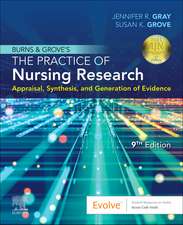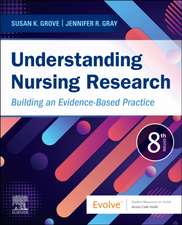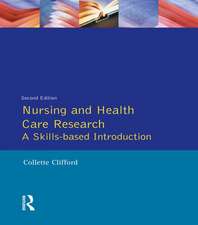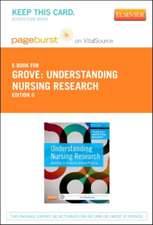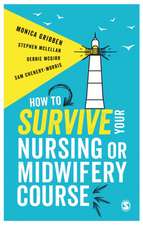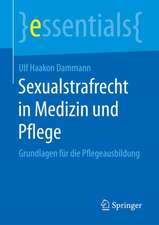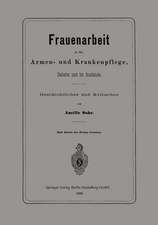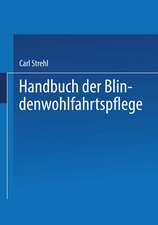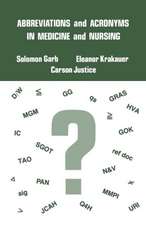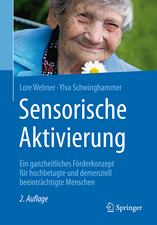Statistics for Nursing Research: A Workbook for Evidence-Based Practice
Autor Susan K. Grove, Daisha J. Cipheren Limba Engleză Paperback – 16 apr 2024
Preț: 314.19 lei
Preț vechi: 330.73 lei
-5% Nou
Puncte Express: 471
Preț estimativ în valută:
60.12€ • 64.29$ • 50.13£
60.12€ • 64.29$ • 50.13£
Carte disponibilă
Livrare economică 21 martie-04 aprilie
Preluare comenzi: 021 569.72.76
Specificații
ISBN-13: 9780323930505
ISBN-10: 0323930506
Pagini: 528
Dimensiuni: 216 x 276 mm
Greutate: 1.57 kg
Ediția:4
Editura: Elsevier
ISBN-10: 0323930506
Pagini: 528
Dimensiuni: 216 x 276 mm
Greutate: 1.57 kg
Ediția:4
Editura: Elsevier
Cuprins
PART 1: Understanding Statistical Methods
1. Identifying Levels of Measurement: Nominal, Ordinal, Interval, and Ratio
2. Identifying Probability and Nonprobability Sampling Methods in Studies
3. Understanding the Sampling Section of a Research Report: Population, Sampling Criteria, Sample Size, Refusal Rate, and Attrition Rate
4. Understanding Reliability of Measurement Methods
5. Understanding Validity of Measurement Methods
6. Understanding Frequencies and Percentages
7. Interpreting Line Graphs
8. Measures of Central Tendency: Mean, Median, and Mode
9. Measures of Dispersion: Range and Standard Deviation
10. Description of a Study Sample
11. Interpreting Scatterplots
12. Algorithm for Determining the Appropriateness of Inferential Statistical Techniques
13. Understanding Pearson Product-Moment Correlation Coefficient
14. Understanding Simple Linear Regression
15. Understanding Multiple Linear Regression
16. Understanding Independent Samples t-test
17. Understanding Paired or Dependent Samples t-test
18. Understanding Analysis of Variance (ANOVA) and Post Hoc Analyses
19. Understanding Pearson Chi Square
20. Understanding Spearman Rank-Order Correlation Coefficient
21. Understanding Mann-Whitney U Test
22. Understanding Wilcoxon Signed-Rank Test
PART 2: Conducting and Interpreting Statistical Analyses
23. Selecting Appropriate Analysis Techniques for Studies
24. Describing the Elements of Power Analysis: Power, Effect Size, Alpha, and Sample Size
25. Conducting Power Analysis
26. Determining the Normality of a Distribution
27. Calculating Descriptive Statistics
28. Handling Missing Data NEW!
29. Calculating Pearson Product-Moment Correlation Coefficient
30. Calculating Simple Linear Regression
31. Calculating Multiple Linear Regression
32. Calculating t-tests for Independent Samples
33. Calculating t-tests for Paired (Dependent) Samples
34. Calculating the Mann-Whitney U Test NEW!
35. Calculating Analysis of Variance (ANOVA) and Post Hoc Analyses Following ANOVA
36. Calculating Sensitivity and Specificity
37. Calculating Pearson Chi-Square
38. Calculating Odds Ratio and 95% Confidence Intervals
References
Appendices
Appendix A: Critical Values for Student's t Distribution
Appendix B: Critical Values of r for Pearson Product Moment Correlation Coefficient
Appendix C: Critical Values of F for ? = 0.05 and ? = 0.01
Appendix D: Critical Values of the ?2 Distribution
Index
1. Identifying Levels of Measurement: Nominal, Ordinal, Interval, and Ratio
2. Identifying Probability and Nonprobability Sampling Methods in Studies
3. Understanding the Sampling Section of a Research Report: Population, Sampling Criteria, Sample Size, Refusal Rate, and Attrition Rate
4. Understanding Reliability of Measurement Methods
5. Understanding Validity of Measurement Methods
6. Understanding Frequencies and Percentages
7. Interpreting Line Graphs
8. Measures of Central Tendency: Mean, Median, and Mode
9. Measures of Dispersion: Range and Standard Deviation
10. Description of a Study Sample
11. Interpreting Scatterplots
12. Algorithm for Determining the Appropriateness of Inferential Statistical Techniques
13. Understanding Pearson Product-Moment Correlation Coefficient
14. Understanding Simple Linear Regression
15. Understanding Multiple Linear Regression
16. Understanding Independent Samples t-test
17. Understanding Paired or Dependent Samples t-test
18. Understanding Analysis of Variance (ANOVA) and Post Hoc Analyses
19. Understanding Pearson Chi Square
20. Understanding Spearman Rank-Order Correlation Coefficient
21. Understanding Mann-Whitney U Test
22. Understanding Wilcoxon Signed-Rank Test
PART 2: Conducting and Interpreting Statistical Analyses
23. Selecting Appropriate Analysis Techniques for Studies
24. Describing the Elements of Power Analysis: Power, Effect Size, Alpha, and Sample Size
25. Conducting Power Analysis
26. Determining the Normality of a Distribution
27. Calculating Descriptive Statistics
28. Handling Missing Data NEW!
29. Calculating Pearson Product-Moment Correlation Coefficient
30. Calculating Simple Linear Regression
31. Calculating Multiple Linear Regression
32. Calculating t-tests for Independent Samples
33. Calculating t-tests for Paired (Dependent) Samples
34. Calculating the Mann-Whitney U Test NEW!
35. Calculating Analysis of Variance (ANOVA) and Post Hoc Analyses Following ANOVA
36. Calculating Sensitivity and Specificity
37. Calculating Pearson Chi-Square
38. Calculating Odds Ratio and 95% Confidence Intervals
References
Appendices
Appendix A: Critical Values for Student's t Distribution
Appendix B: Critical Values of r for Pearson Product Moment Correlation Coefficient
Appendix C: Critical Values of F for ? = 0.05 and ? = 0.01
Appendix D: Critical Values of the ?2 Distribution
Index

